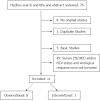Association between vitamin D and hepatitis C virus infection: a meta-analysis
- PMID: 24124339
- PMCID: PMC3793147
- DOI: 10.3748/wjg.v19.i35.5917
Association between vitamin D and hepatitis C virus infection: a meta-analysis
Abstract
Aim: To evaluate the association between 25-hydroxyvitamin D [25(OH)D] and sustained virological response (SVR) in hepatitis C virus (HCV) infected individuals.
Methods: Relevant studies were identified by systematically searching MEDLINE databases up to March 2012 and abstracts of the European and American Congress of Hepatology conducted in 2011. Studies must provide information on SVR and the levels of 25(OH)D₃ and/or 25(OH)D₂ [henceforth referred to as 25(OH)D] in sera samples from HCV infected individuals. The inclusion criteria were: clinical studies that included HCV infected patients aged older than 18 years regardless of HCV genotype or ethnic group; provided information on SVR rates; and were reported in the English language as full papers. Due to the heterogeneity of studies in categorizing serum vitamin D levels, a cut-off value of 30 ng/mL of serum 25(OH)D was used. Heterogeneity was assessed using I² statistics. The summary odds ratios with their corresponding 95%CI were calculated based on a random-effects model.
Results: Overall, 11 studies (8 observational and 3 interventional) involving 1575 individuals were included and 1117 HCV infected individuals (71%) showed low vitamin D levels. Most of the studies included mono-infected HCV individuals with the mean age ranging from 38 to 56 years. Four studies were conducted in human immunodeficiency virus/HCV infected individuals. Regarding vitamin D measurement, most of the studies employed radioimmunoassays (n = 5) followed by chemiluminescence (n = 4) and just one study employed high performance/pressure liquid chromatography (HPLC). Basal vitamin D levels varied from 17 to 43 ng/mL in the studies selected, and most of the HCV infected individuals had genotype 1 (1068/1575) with mean viral load varying from log 4.5-5.9 UI/mL. With regard to HCV treatment, most of the studies (n = 8) included HCV individuals without previous treatment, where the pooled SVR rate was 46.4%. High rates of SVR were observed in HCV individuals with vitamin D levels above 30 ng/mL (OR = 1.57; 95%CI: 1.12-2.2) and those supplemented with vitamin D (OR = 4.59; 95%CI: 1.67-12.63) regardless of genotype.
Conclusion: Our results demonstrated high prevalence of vitamin D deficiency and high SVR in individuals with higher serum vitamin D levels or receiving vitamin D supplementation.
Keywords: Hepatitis C; Meta-analysis; Sustained virological response; Therapy; Vitamin D.
Figures



References
-
- Lavanchy D. Evolving epidemiology of hepatitis C virus. Clin Microbiol Infect. 2011;17:107–115. - PubMed
-
- Romero-Gomez M, Eslam M, Ruiz A, Maraver M. Genes and hepatitis C: susceptibility, fibrosis progression and response to treatment. Liver Int. 2011;31:443–460. - PubMed
-
- Eslam M, Aparcero R, Kawaguchi T, Del Campo JA, Sata M, Khattab MA, Romero-Gomez M. Meta-analysis: insulin resistance and sustained virological response in hepatitis C. Aliment Pharmacol Ther. 2011;34:297–305. - PubMed
-
- de Rueda PM, López-Nevot MÁ, Sáenz-López P, Casado J, Martín-Casares A, Palomares P, Quiles R, Gila A, Romero-Gómez M, Pavón EJ, et al. Importance of host genetic factors HLA and IL28B as predictors of response to pegylated interferon and ribavirin. Am J Gastroenterol. 2011;106:1246–1254. - PubMed
Publication types
MeSH terms
Substances
LinkOut - more resources
Full Text Sources
Other Literature Sources
Medical

